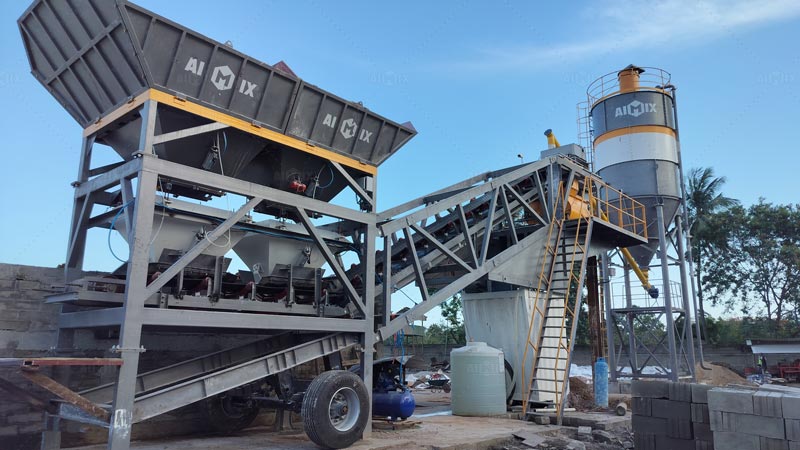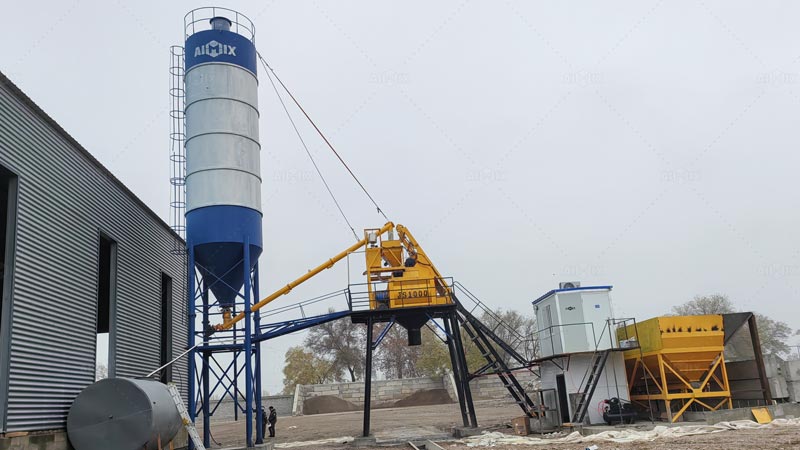When considering investment in a mini concrete plant, it’s important to look beyond the sticker price. From installation and operation to maintenance and eventual resale or replacement, the total cost of ownership spans the full life cycle of the equipment. Understanding these costs will help construction businesses, contractors, and startups make more informed financial decisions. This article breaks down each cost element of a small concrete batching plant to guide smarter investments and higher returns.
Initial Investment Costs
Purchase Price of the Mini Concrete Plant
The first and most obvious cost is the plant itself. A typical mini concrete plant(mini planta de concreto)—suitable for producing 25 to 50 cubic meters of concrete per hour—costs between $20,000 and $100,000. This range is influenced by various factors:
- Production capacity (m³/h)
- Type (stationary vs. mobile)
- Automation level (manual, semi-auto, or full automatic)
- Concrete mixing method (dry vs. wet mix)
- Material storage and delivery systems
- Origin of components (local vs. imported)
Transport and Installation
Logistics add significant cost. Depending on distance, shipping can range from $2,000 to $10,000. Installation costs—including civil works like foundations, electrical and water systems, and setup labor—usually add another $5,000 to $20,000. Mobile plants may reduce foundation costs but could require additional permits for mobility and transport regulations.

Operational Costs
Labor Costs
A small concrete batching plant(planta de concreto peru) typically needs 2–3 workers: one to operate the control system, one for loading and monitoring aggregates, and another for quality control or maintenance. Monthly labor costs depend on the country and skill level but generally range from $1,000 to $5,000 for a team. Training costs should also be factored in—especially when working with automated systems or advanced software interfaces.
Energy and Water Consumption
Electricity powers the motors, belts, and mixers. Monthly electrical bills vary but average $500–$1,500. Water consumption is significant in wet mix plants and for cleaning equipment, amounting to $200–$500 per month. Plants with water recycling systems can cut these costs long-term, albeit with higher upfront investment.
Raw Material Costs
Materials like cement, aggregates, and admixtures are ongoing expenses. Raw material costs are typically the largest operational expense, accounting for over 60% of production cost. Using a well-calibrated batching system ensures accurate dosing and minimizes material waste, which is critical for profitability. For example, even a 1% error in cement weight can cost thousands annually in material overuse.

Maintenance and Repairs
Preventive Maintenance
Routine maintenance tasks include cleaning, lubrication, calibration, and inspections. These tasks prevent wear and tear, enhance productivity, and reduce unplanned downtime. Expect to budget around $1,000 to $3,000 per year for preventive maintenance. Scheduling downtime for maintenance during off-peak periods helps avoid production loss.
Replacement Parts
Spare parts like mixer blades, belts, load cells, and sensors will wear over time. A good rule is to budget 2–5% of the plant’s value annually for spare parts and minor repairs. For a $60,000 concrete plant(planta de concreto), that’s about $1,200–$3,000 per year. Buying OEM parts may cost more, but they ensure compatibility and longevity.
Depreciation and Asset Value
A mini concrete plant typically has a useful life of 10–15 years, depending on maintenance and usage. Depreciation is often calculated using the straight-line method. For example, a $60,000 plant depreciated over 10 years equates to $6,000/year. However, resale value may offset some of this cost. Well-maintained equipment can still fetch 30–50% of its original value after 7–10 years.
Compliance and Environmental Costs
Depending on your location, environmental regulations may require dust control systems, enclosed storage, or water treatment units. These compliance-related costs can range from $2,000 to $10,000. In addition to meeting local regulations, such features may also be attractive selling points for environmentally conscious clients or government contracts.
Technology and Upgrades
Some batching plants offer smart technology such as automated control panels, remote diagnostics, real-time production tracking, and cloud-based data analytics, such as AIMIX. While these systems can increase initial costs by 10–20%, they improve accuracy, reduce errors, and streamline maintenance. Over time, these features contribute to lower life cycle costs and higher productivity.
Return on Investment (ROI)
Let’s take a simplified example. If your mini concrete plant produces 25 m³/day and sells concrete at $60/m³, that’s $1,500/day in revenue. Subtract $1,000/day for labor, materials, and energy, and you have $500/day in net income. At that rate, a $50,000 plant pays for itself in about 100 working days—just 4–6 months depending on project frequency. After the break-even point, ongoing profits can be reinvested or used to expand operations.
Conclusion
When evaluating the purchase of a mini concrete plant, it’s essential to look at the full picture. Beyond the upfront price tag, long-term expenses like labor, maintenance, energy, and compliance shape the actual cost of ownership. The most successful contractors consider these life cycle costs and plan accordingly, ensuring their concrete batching plant remains profitable and reliable for years. By doing so, you don’t just buy a machine—you invest in a sustainable production solution.